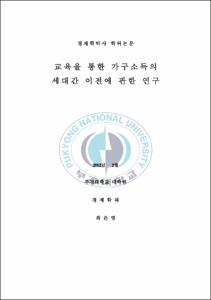교육을 통한 가구소득의 세대간 이전에 관한 연구
- Alternative Title
- A Study on the schooling and intergenerational transfer of household income
- Abstract
- A Study on the schooling and intergenerational
transfer of household income
Eun Young Choi
Department of Economics, The Graduate School,
Pukyong National University
Abstract
This study aims to review empirically whether educational and income gaps are transferred between generations and to find the route to transfer educational and income gaps between generations. Furthermore, transfer of educational and income gaps between generations according to income brackets is analyzed empirically through standardized coefficients, and the difference between income brackets is looked into.
「Korea Labor and Income Panel Study (KLIPS)」 of the Korea Labor Institute is used as the data. This study constructs materials which merges data on parent generation investigated in the first and second years with one on children moved out in the 10th and 11th years focusing on the KLIPS. Based on the material, a series of casual links between parents' educational and income gaps and children's one are analyzed.
First, parents' educational levels affect children's levels directly and parents' income levels influence children's one. Furthermore, children's educational levels have an effect on their income levels. Accordingly, parents' educational levels seriously affect children's educational levels as well as parents' income levels, and children's education will influence their children's one, thus there is transfer between generations.
Second, parents' incomes are divided into the highest and lowest 20%s, and then degree of transfer between generations according to income brackets is assumed. As a result, parents' incomes show differences between classes to determine children's educational levels. In the low-income class, when parents' incomes increase, they invest children's education more elastically, and the higher educational levels of children family grow, the higher income levels of children one increase, but the growth is slight. That is to say that return on investment in children's education is low in the low-income class.
Third, elasticity of family income between generations and contribution degree of family income to education are calculated in the analysis on contribution degree of education to income elasticity. Parents' income levels affect children's education levels, and if children's educational levels contribute to children's income, transfer part can be disassembled using this link through the route of educational levels in the income elasticity between parents and children. Thus, the contribution degree of family income to education can be computed by contribution degree of parents' income to children's education and return on investment in education.
Fourth, when contribution degree of education to income elasticity in the highest and lowest 20% is assumed, the elasticity in the lowest 20% is the higher. The contribution degree of parents' incomes to children's education is larger in the lowest 20%, and return on investment in education is bigger in the highest 20%. The educational share of the highest is even greater than the lowest 20%.
Fifth, the aspects that incomes between generations are transferred according to income brackets are examined with tables and graphs. The rate of passage within generation is looked at through transfer line between parents and children. The rate of passage from parents to children is 31.1%.
This study finds educational and income transfer between generations empirically, thus dynamics of our society is grasped and hereditary position is checked. Furthermore, this is the first study to analyze data according to income brackets using the KLIPS. The study looks into which differences there are in the income transfer between generations through education of low-income and high-income classes empirically. Lastly, this is the empirical study that understands importance of role of education in income transfer between generations with estimated figures.
Keyword : Intergenerational transfer, Household Income, Educational gap, Income inequality , Human capital theory
- Issued Date
- 2012
- Awarded Date
- 2012. 2
- Type
- Dissertation
- Publisher
- 부경대학교 일반대학원
- Alternative Author(s)
- Choi, Eun Young
- Affiliation
- 부경대학교 일반대학원
- Department
- 대학원 경제학과
- Advisor
- 홍장표
- Table Of Contents
- < 목 차 >
Abstract
제1장 서론 1
제1절 연구의 필요성과 목적 1
제2절 연구방법 4
제3절 논문의 구성 6
제2장 이론적 배경 8
제1절 교육과 소득의 상관관계에 관한 이론 8
1. 인적자본이론 9
2. 선별가설과 신호발송 13
제2절 세대간 이전에 관한 이론 16
제3장 선행연구 검토와 연구과제 19
제1절 선행연구 19
1. 교육비지출과 교육투자수익률에 관한 연구 19
2. 교육을 통한 세대간 경제적 대물림에 관한 연구 23
제2절 연구과제 28
제4장 분석모형 및 자료 30
제1절 분석방법 30
제2절 실증모형 32
1. 부모소득 결정요인 추정모형 32
2. 자녀의 교육수준 결정요인 추정모형 33
3. 자녀소득 결정요인 추정모형 34
4. 소득탄력성에 대한 교육의 기여도 추정모형 36
제3절 분석자료 38
제5장 실증분석 결과 52
제1절 소득수준의 세대간 이전과 교육 52
1. OLS 추정결과 52
2. 2SLS와 3SLS 추정결과 56
제2절 소득계층별 교육과 소득의 세대간 이전 61
1. OLS 추정결과 61
2. GLS 추정결과 71
제3절 소득탄력성에 대한 교육의 기여도 81
1. 가구소득의 세대간 탄력성 추정결과 81
2. 가구소득의 교육의 기여도 추정결과 82
3. 소득계층별 소득의 세대간 이행 88
제6장 결론 92
95
100
- Degree
- Doctor
- Files in This Item:
-
-
Download
 교육을 통한 가구소득의 세대간 이전에 관한 연구.pdf
기타 데이터 / 1.36 MB / Adobe PDF
교육을 통한 가구소득의 세대간 이전에 관한 연구.pdf
기타 데이터 / 1.36 MB / Adobe PDF
-
Items in Repository are protected by copyright, with all rights reserved, unless otherwise indicated.